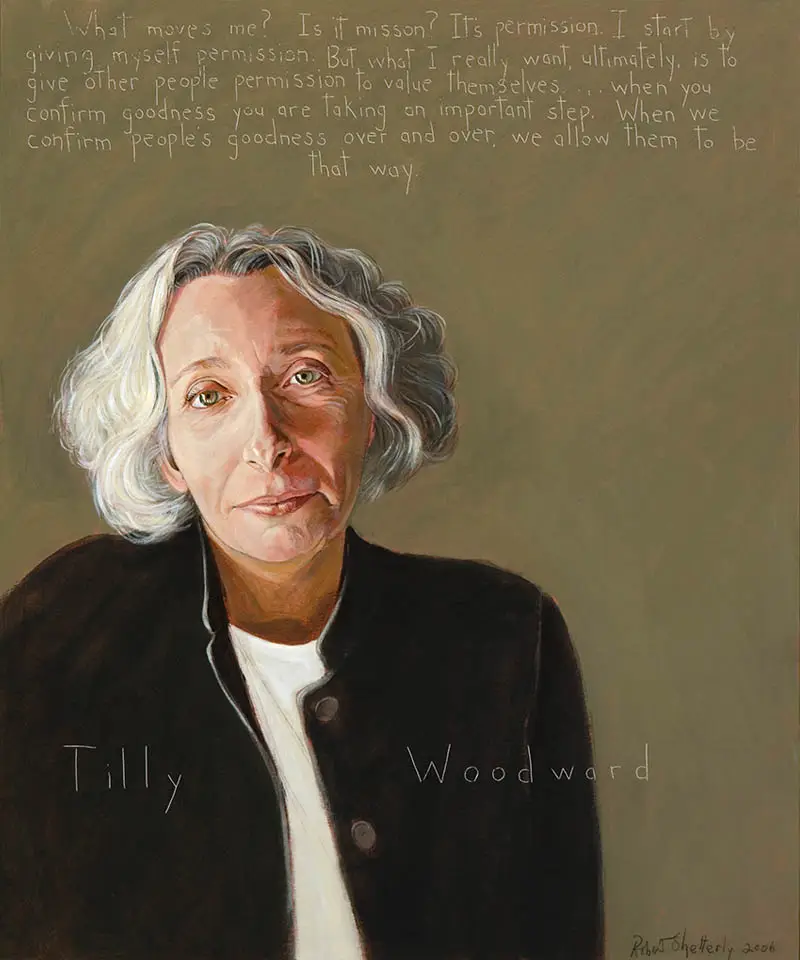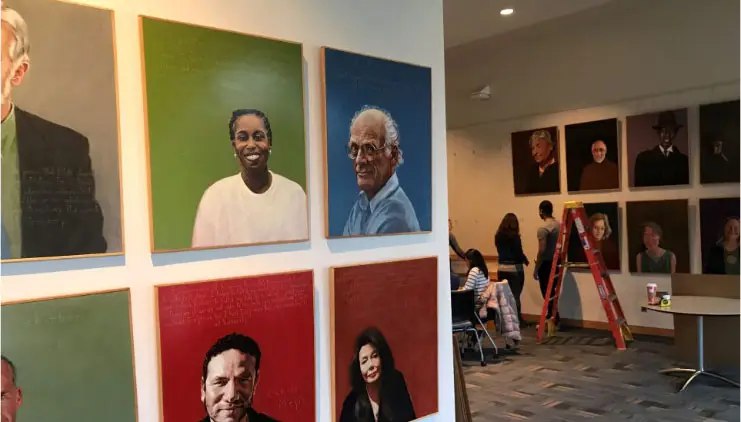
Tilly Woodward
Tilly Woodward
Artist, Professor : b. 1957
“What moves me? Is it mission? It’s permission. I start by giving myself permission. But what I really want, ultimately, is to give other people permission to value themselves. …[W]hen you confirm goodness you are taking an important step. When we confirm people’s goodness over and over, we allow them to be that way.”
Speaking Truth to Youth
Artist Tilly Woodward talks about why and how art is a voice for activism.
Biography
Tilly Woodward is an artist whose creations, inspired by global social problems, offer both dialogue and healing, and show that tragedies and triumphs of all kinds can happen to anyone, and affect everyone. Tilly Woodward is also the founder and director of the Pella Community Art Center, and is the Curator of Academic and Community Outreach at Grinnell College.
Woodward grew up in Illinois and Missouri. She earned her MFA in sculpture at the University of Kansas in 1982. In school, her work was very personal. That changed when she saw photographs of children, killed in a battle, laid out in rows for burial. She writes, “It was a pivotal moment for me in which I started to become aware of a world larger than myself.” This discovery led to “Children as Victims,” a series of large pastel drawings taken from the disturbing photographs.
In 1985, she installed ten painted billboards along route I-70 from St. Louis to Kansas City. The billboards, which became known as the I-70 Project, depicted events of a variety of historical events from the Holocaust to boxing matches. By placing the images in the Midwest, far away in time and distance from where the events took place, Woodward asked people to consider them as ethical dilemmas that concern us all.
After moving to Pella, Iowa in 1990, Woodward’s art opened up in scope and intention. She felt that, “It no longer seemed enough to merely point out a problem without offering some step toward a positive solution.” In “Portraits of Dubuque,” a response to racism, she drew portraits of diverse individuals, nominated for having performed a good deed or act of kindness. Woodward hoped the project would “help people recognize each other as individuals and better recognize human kindness regardless of race, gender, age, faith, or economic background.”
Her “AIDS Portrait Project,” combining portraits with words, gave a voice to Iowans living with AIDS. In her community, Woodward had heard it said, “AIDS couldn’t happen here because we live in a small, Christian town. I also heard it said that AIDS was a judgment from God, and I wanted my children and others to learn that AIDS can happen anywhere, and that all people deserve compassion and dignity in sickness and death.”
In 2004, she created the Ribbon Monument. At its initial installation, victims of rape and sexual abuse were invited to write their stories on ribbons that were posted on thin metal poles. As with Buddhist prayer flags and Tibetan Thankas, when a ribbon moves in the wind or is lifted by a passerby, its story is sent out into the world. With this project, Woodward hopes to end the silent suffering of these victims, so often doubted, even blamed for what happened to them. As Woodward writes, “This way the stories are told, they are visible, and they are moved as prayers for healing by the wind.”
The Pella (Iowa) Art Community Center, created by Woodward in 1990, serves art students of all ages, from small children to seniors. In 2006 alone, the Center hosted over 17,000 participants, a remarkable feat considering the town of Pella has 10,000 residents. At the Center, students are invited to work with each other, with volunteers, and with local and visiting artists. Whatever the participants want to create, the opportunity, supplies, and support are found at the Center. This is a community project built around a shared desire for creative expression. In 2007, Tilly Woodward took the job of Curator of Academic and Community Outreach for the Faulconer Gallery at Grinnell College, where she works to integrate art into the curriculum and life of the college and community. She frequently collaborates with faculty, staff, students and townspeople to create art projects as teaching tools that respond to specific issues. For a symposium on the Arctic, she created a 10 x 12 x 1 foot wall of ice that served as a screen for projected images until it melted away. The Ice Wall stood just outside the lecture hall and was visible through a large bank of windows behind the speakers.
Programs
Americans Who Tell the Truth (AWTT) offers a variety of ways to engage with its portraits and portrait subjects. Host an exhibit, use our free lesson plans and educational programs, or engage with a member of the AWTT team or portrait subjects.

Education
AWTT has educational materials and lesson plans that ask students to grapple with truth, justice, and freedom.

Exhibits & Community Engagement
AWTT encourages community engagement programs and exhibits accompanied by public events that stimulate dialogue around citizenship, education, and activism.